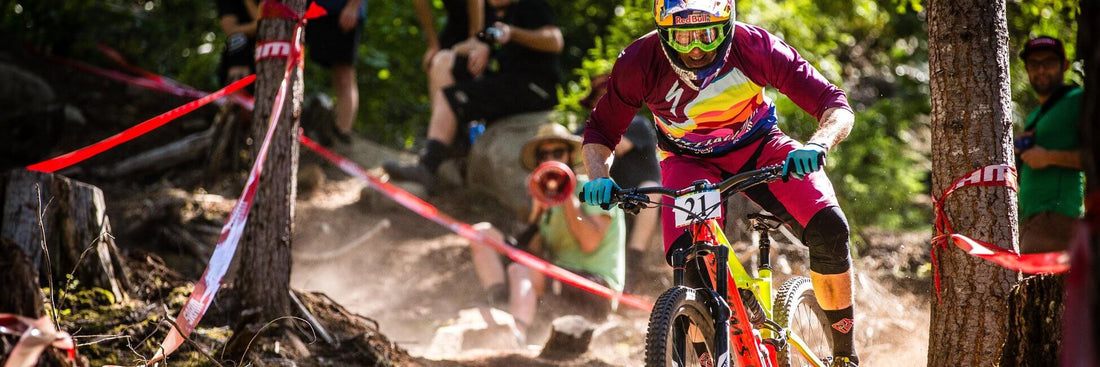
Enduro Mountain Bike racing explained
Aloha RushShare
What is enduro mountain biking, and how does an enduro mountain bike race work? What terrain is to be expected, and what sort of bike is needed? Find out everything you need to know.
Enduro mountain bike racing is essentially a tough day – or a few tough days – out on the bike, usually spent riding between multiple timed, predominantly downhill stages.
Race formats vary, but the most common races follow a route in which riders must finish liaison stages within a certain amount of time in order to arrive at a series of timed stages.
These events are usually run over the course of one or two days, sometimes with no practice allowed (blind racing), or minimal practice (either on days before the event, or a one-run recce before racing a stage).
In these races, riders set out individually or in pairs from the paddock to pedal or use mechanical uplift (chairlifts, gondolas etc) to access each stage. Stages are then timed individually, in the same way that a downhill race is timed. Times from each stage are added up after the day or days of racing to determine a winner.
In most races, riders must use the same frame, fork and wheels throughout the race and they are not allowed outside assistance (either for mechanical support, strategy or food supplies) except at designated times and zones during the event. This puts a focus on a rider’s ability to prepare and sustain themselves for a day out on the bike, as well as defining the sturdy all-rounder mountain bikes most people ride today.
Another race format is the mass start enduro, made famous by Alpe d’Huez’s annual Megavalanche. In these events, riders tackle a qualifying race prior to the main event to determine their position on a start grid (set up in lines according to qualifying results) for a one-run top-to-bottom dash for glory.
How did enduro MTB racing start?
Multi-stage downhill-biased events have taken place throughout mountain biking’s history, but enduro racing as we now know it is often cited as starting in France. In 2003, Fred Glo (now one of the Enduro World Series organisers) and his team held the first Tribe 10000 event in Val d’Allos, soon after that a national enduro series was formed. The French series was later joined by the Superenduro series in Italy, which took a new direction in allowing practice of the stages and most uphill liaisons being pedal power only.
What do the enduro race courses look like?
Enduro race stages are predominantly downhill, often on raw, natural terrain. They vary from short sprints to extreme physical tests, sometimes taking 15 minutes and above even for the fastest racers. From rocks to tree roots, flat-out fast to tricky technical, an enduro race can – and often does – comprise just about every element of mountain biking.
An enduro race can happen anywhere, but events generally take place in mountainous areas. This means tough uphill pedals during the liaisons and, depending on the organiser, sometimes these connections are tougher than others. The organiser sets the amount of time riders have in which to make it from one stage to the next, and if they take longer (thus missing their start time), they are penalised.
Enduro MTB bikes
The bikes used for enduro racing probably resemble the bike you ride – that is because they are the sorts of all-mountain bikes the majority of riders use today. They have somewhere around 140-170mm suspension travel, 27.5 or 29-inch wheels, a dropper seat post, strong brakes and big discs for long descents, and they are as light as possible while still able to survive long days of punishing terrain. If a bike can make it through an Enduro World Series event, that means it is tough as nails.
Enduro MTB Events
Many nations now have popular enduro series, with the likes of the UK Gravity Enduro in the UK, Superenduro in Italy, Big Mountain Enduro in the USA, the Enduro Series in France, and so on.
There are also countless one-off participant events with festival-like atmosphere, such as the hugely popular ‘ArdRock Enduro in the UK, which has thousands of competitors and visitors, live music and exhibition areas.
Enduro World Series
The Enduro World Series was inaugurated in 2013 in Punta Ala, Italy. This historic event was won by Fabien Barel (FR) and Tracey Moseley (GB), with Jerome Clementz (FR) and Tracey Moseley crowned the first series victors – claiming the Enduro World Champion titles – later in the year.
Since then, enduro racing has surged in popularity, with national and regional series taking place across the world. The EWS is in its sixth season (in 2018) and going from strength to strength: in 2017, 2960 competitors from 42 countries started a race (there were eight total events), there were 31 official teams and events highlights shows were seen across the world online and on TV.
There have been six elite Enduro World Series winners so far: Jerome Clementz, Tracey Moseley, Jared Graves, Cécile Ravanel, Sam Hill and Richie Rude.
© Matt Wragg
Written by James McKnight











